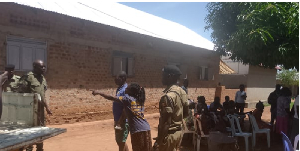- Home - News
- TWI News | TV
- Polls
- Year In Review
- News Archive
- Crime & Punishment
- Politics
- Regional
- Editorial
- Health
- Ghanaians Abroad
- Tabloid
- Africa
- Religion
- Election 2020
- Coronavirus
- News Videos | TV
- Photo Archives
- News Headlines
- Press Release
General News of Thursday, 15 March 2012
Source: samuel innocent
Child Labour Monitoring System launched
THE GHANA Child Labour Monitoring System (GCLMS) has been launched on Wednesday at Likpe Bakwa in the Hohoe Municipality of the Volta Region, with a call on parents/guardians and all concerned stakeholders to seize the opportunity and make the affected areas child labour free zones, particular where children were engaged in hazardous activities and other Worst Form of Child Labour (WFCL). The well-attended launch attracted representatives from the International Cocoa Initiative, World Cocoa Foundation, Chocolate and Cocoa Industry, International Labour Organization (ILO), American Embassy, General Agriculture Workers Union of the Trades Union Congress, COCOBOD, Ministry of Employment and Social Welfare, and the Hohoe Municipal Assembly.
In 2001, there were agitations in the Western media, especially in the USA and the UK about child exploitation in the cocoa industry in Ivory Coast and, by association and proximity, Ghana. There were threats by some consumers to boycott chocolates as a result of child labour. The governments of these countries also threatened to discontinue purchasing cocoa from West Africa. This was a matter of grave concern to the Republic of Ghana, considering that cocoa contributes over 30 per cent of Ghana’s Gross Domestic Product.
Accordingly, in August 2006, the Government through the Ministry of Employment and Social Welfare instituted the National Programme for the Elimination of Child Labour in Cocoa (NPECLC) to deal with the problem of WFCL in Ghana’s cocoa sector. The programme is being implemented under the auspices of the Ministry of Employment and Social Welfare. It was created in response to agitations in foreign countries about the use of child slave labour in the production of cocoa in West Africa.
The NPECLC with the support from both local and international partners effectively developed and validated the GCLMS in 2011, which is a holistic and dynamic process for eliminating the Worst Forms of Child Labour. The process involves direct observation, repeated regularly to identify child labourers and to determine risks, to which they are exposed to, refer them to services to verify that they have been removed and track them to ensure that they have satisfactory and sustainable alternatives. Cocoa Production in Ghana is both a social and cultural practice where children undergo a process of socialization in the cause of their upbringing. This involves children leaning to do household chores in addition to the vocations that their parents engage in. In many instances, some stakeholders and foreign partners misinterpret these acts of socialization for child labour. The establishment of the NPECLC also sought to explain the differences between child labour and child work in cocoa production. Deputy Minister of Employment and Social Welfare, Mr. Antwi-Boasiako Sekyere, who performed the launch, said child labour was not good for the child, parents or the state and identified poverty as the main cause of child labour. He insisted that even when one engages in it, it cannot be the key means of producing cocoa, and yet it becomes a hindrance to the development and future security of the child. He, therefore, called on parents and guardians to offer opportunities to their children to develop their talents to enable them grow into responsible leaders in future, invariably he said, this starts with a commitment to the education of the children on whom the future of Ghana lies.
The Deputy Minister noted that in a bid to ensure that children had the opportunity to enroll in schools, the Government had instituted various pragmatic to provide children with the opportunity to pursue education. Notable among them are the Capitation Grant, Livelihood Empowerment Against Poverty, Free Textbooks/Exercise books, School Feeding Programme, Free uniforms, and removing children from under trees.
Mr. Sekyere maintained that the major tool to track down the problem of WFCL is the GCLMS, emphasizing that it would only be effective when all partners worked together in concert. “As partners we are all aware of the negative consequences of child labour which does not only affect the child but the whole community and the country at large,” he noted.
The National Programme Manager of the NPECLC, Professor Richard Bani, said the launch of the GCLMS would go a long way to monitor children on a continuous basis and identify those in child labour or at risk of it to inform the appropriate remediation service to be provided.
He called on chiefs, opinion leaders and all other concerned partners to come together to fight child labour in order to enable the children pursue education and develop themselves for a brighter future to contribute their quota to the development of the country and the world at large.
According to him, reports from the various Municipal and District Assemblies revealed that the Chief Executives and other opinion leaders sensitized on the programme were doing well and expressed the hope that in the not too distant future, the WFCL in cocoa districts would be eliminated.
To achieve this, Prof. Bani said “we must not disregard the complex nature of the phenomenon, including the cultural and traditional challenges involved in combating the practice.”
Melane Rose Boyce the Representative of Chocolate and Cocoa Industry commended Ghana for the feat chalked in developing the GCLMS. She said the GCLMS was a critical tool which would allow communities to become sensitized, educated, organized and empowered to take action on behalf of their own children. “We are extremely appreciative of the efforts that NPECLC and the Ministry have made to move this system forward. As you know, the industry has already put US$2 million in funding for a new Public Private Partnership with the ILO-IPEC to support the Ministry’s efforts. This pilot will allow communities to become advocates for their own children, and for the resources they need to support their children at the community level,” she maintained.
Ms Boyce hoped that the strong partnership will ultimately create a future where children in cocoa communities in conditions vulnerability are identified, and linked with services they need to be safe, secure and educated to enable them take their place as citizens on a global stage, saying, “Let us re-double our efforts on their behalf as we launch this new GCLMS effort together today.” The Hohoe Municipal Chief Executive, Dr. Margaret Kweku pledged the Assembly’s unflinching support for the success of the programme, saying that the introduction of community registers by the programme in the communities was a laudable one and a step in the right direction.
“As part from its use as a monitoring system, we believe that it will also enhance the database of the Municipality as a whole for budgeting and planning purposes. Let me give you the assurance that the Assembly will do all it can to support the programme to succeed since we believe this monitoring system will serve as a safeguard to reduce if not eliminate completely the issue of child labour and child trafficking in the Municipality,” she noted.










